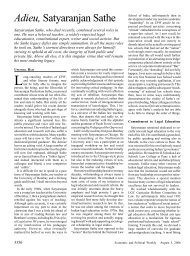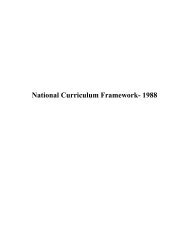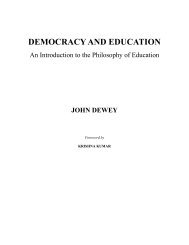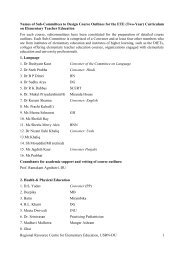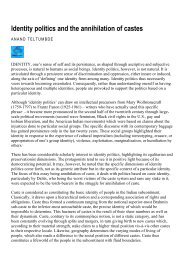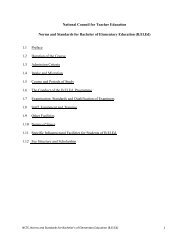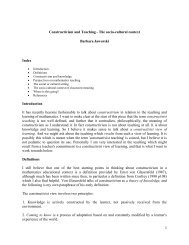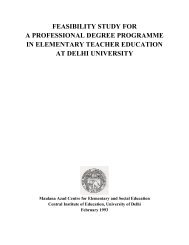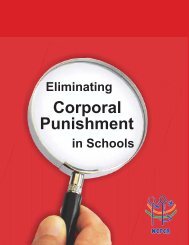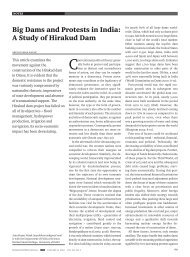Minority Rights in Education - eledu.net
Minority Rights in Education - eledu.net
Minority Rights in Education - eledu.net
You also want an ePaper? Increase the reach of your titles
YUMPU automatically turns print PDFs into web optimized ePapers that Google loves.
can <strong>in</strong>tervene <strong>in</strong> the m<strong>in</strong>ority education <strong>in</strong>stitutions. Even tribunalscan be constituted for adjudication of dispute between the employeesand the management. However, the presid<strong>in</strong>g officer of thetribunal is to be selected by the high court and has to be a judicialofficer of the rank of district judge. (7) The management has muchwider power <strong>in</strong> the constitution of the manag<strong>in</strong>g committee.All the above mentioned advantages are adm<strong>in</strong>istrative <strong>in</strong>nature. Significantly, the study conducted <strong>in</strong> Mumbai [Ja<strong>in</strong> 1992]showed that operat<strong>in</strong>g <strong>in</strong> the common political economy, m<strong>in</strong>oritiesdo not rema<strong>in</strong> <strong>in</strong> a position to practice qualitatively differentpedagogy, however relevant it may be to the cultural developmentof the community. More specifically, <strong>in</strong> a political economywhere degrees rema<strong>in</strong> l<strong>in</strong>ked to jobs and where the <strong>in</strong>stitutionsare dependent upon the government resources for survival, itbecomes essential to follow common pedagogy recognised bythe state as it ensures jobs for the students as well as theiradmissions <strong>in</strong> the <strong>in</strong>stitutions offer<strong>in</strong>g higher studies. Suchassurances provide credibility to the <strong>in</strong>stitution, which furthersits demand among the students. Ja<strong>in</strong> (1992) studied two educational<strong>in</strong>stitutions and observed that the academic standard ofthe <strong>in</strong>stitutions was not sacrificed for their m<strong>in</strong>ority character.Institutions were found not to compromise on merit while admitt<strong>in</strong>gstudents. Admission of the community members, who could notpay fees, was also found to be resisted.One f<strong>in</strong>ds that the market requirements have ensured secularand ma<strong>in</strong>stream education <strong>in</strong> the m<strong>in</strong>ority education <strong>in</strong>stitutionswith spaces for extraord<strong>in</strong>ary community oriented educationreduced to conduct<strong>in</strong>g of a few extra curricular courses andprogrammes. This is most conspicuous <strong>in</strong> case of l<strong>in</strong>guisticm<strong>in</strong>orities re<strong>in</strong>stat<strong>in</strong>g their language with more marketablelanguages like English, H<strong>in</strong>di or the regional language of thearea. Deliberations <strong>in</strong> a sem<strong>in</strong>ar on ethnic <strong>in</strong>itiatives <strong>in</strong> educationconducted <strong>in</strong> the Tata Institute of Social Sciences <strong>in</strong> the year2000 revealed that the market compulsions are mak<strong>in</strong>g m<strong>in</strong>oritiessubscribe to English as the medium of <strong>in</strong>struction with a provisionfor special classes to teach their community language to onlythose, who are still <strong>in</strong>terested <strong>in</strong> learn<strong>in</strong>g the language.In such circumstances one understands the suspicion withwhich the government looks at the assertion of the m<strong>in</strong>oritiesfor benefits of Article 30. The assertion is not seen as lead<strong>in</strong>gtowards promotion of culture and education among the m<strong>in</strong>oritiesbut as surpass<strong>in</strong>g prescribed rules and regulations. Desai(1996:108) has mentioned misuse of the benefits extended bythe Article 30. He states,Due to the benefits which may be derived by claim<strong>in</strong>g m<strong>in</strong>oritystatus, a number of unworthy claimants have been scamper<strong>in</strong>g forthis status. For <strong>in</strong>stance, <strong>in</strong> 1993, the Bombay High Court, on atechnicality, held that <strong>in</strong> <strong>M<strong>in</strong>ority</strong> Degree Colleges affiliated toUniversity of Bombay reservation <strong>in</strong> posts was not permissible.With<strong>in</strong> two months about 30 colleges applied for m<strong>in</strong>ority status<strong>in</strong> order to avoid reservation.One cannot deny that, many times, m<strong>in</strong>ority education <strong>in</strong>stitutionsappear to pursue the rights promised <strong>in</strong> the Article 30not for benefits of the m<strong>in</strong>ority community but for exceed<strong>in</strong>ggovernmental requirements like the one mentioned above.However, this makes one wonder more on the rigid and dom<strong>in</strong>eer<strong>in</strong>ggovernmental rules than on the compla<strong>in</strong>t that the benefitsof the Article is not reach<strong>in</strong>g the <strong>in</strong>tended beneficiaries. Thestudy conducted by Ja<strong>in</strong> (1991) shows that the m<strong>in</strong>ority education<strong>in</strong>stitutions use the <strong>in</strong>sights and commitment of the <strong>in</strong>siders tolocate and deal with the problems confront<strong>in</strong>g the community.Both the <strong>in</strong>stitutions studied by Ja<strong>in</strong> had culture specificatmosphere which facilitated easy learn<strong>in</strong>g and encouraged hesitantparents to enroll their children to these <strong>in</strong>stitutions. The<strong>in</strong>stitutions were found to cater to the need of the community,mak<strong>in</strong>g education functional and relevant for the community.They had culture specific atmosphere that encouraged educationof girls and of children from ethnocentric background. These<strong>in</strong>stitutions were also found to conduct vocational or skill enhanc<strong>in</strong>geducation. Mention should also be made of personalefforts of the authorities of the <strong>in</strong>stitution to attract communitymembers to the school and education per se. One feels that theArticle 30 provides an important space to the m<strong>in</strong>orities to mouldtheir educational environment <strong>in</strong> accordance to their requirementsand should be encouraged as it helps the state <strong>in</strong> deal<strong>in</strong>gwith culture-specific forces beh<strong>in</strong>d educational backwardness.Ja<strong>in</strong> (1991) discussed certa<strong>in</strong> fears shared by the governmentofficials expla<strong>in</strong><strong>in</strong>g their resistance towards m<strong>in</strong>ority education<strong>in</strong>stitutions. They felt that, (1) Capacity to monitor admissionof students and teachers gives scope to <strong>in</strong>dulge <strong>in</strong> <strong>in</strong>-groupre<strong>in</strong>forc<strong>in</strong>g strategies. (2) These <strong>in</strong>stitutions have potential tocreate and foster communal atmosphere. (3) Dom<strong>in</strong>ance of aspecific group <strong>in</strong> an <strong>in</strong>stitution <strong>in</strong>creases social gap amongcommunities. It fosters contacts and <strong>in</strong>ter dependency among themembers of the community. This obstructs exposure of themembers to alternate cultures and value structures, h<strong>in</strong>der<strong>in</strong>g theprocess of build<strong>in</strong>g cosmopolitan atmosphere <strong>in</strong> the <strong>in</strong>stitution.(4) Possible presence of ethnocentric and negative stereotypesfor certa<strong>in</strong> communities even among a few members of the staffcan <strong>in</strong>culcate negative feel<strong>in</strong>gs among the students for othercommunities. (5) These <strong>in</strong>stitutions provide a possible base formass mobilisation and thus, rema<strong>in</strong> vulnerable to the fundamentalistpressures.Although acknowledg<strong>in</strong>g the merit of the above argumentsaga<strong>in</strong>st m<strong>in</strong>ority <strong>in</strong>stitutions, one would like to state that thesefears are rooted <strong>in</strong> the structure of Indian society and cannot bedirected towards the m<strong>in</strong>ority <strong>in</strong>stitutions alone. For <strong>in</strong>stance, onef<strong>in</strong>ds pre-em<strong>in</strong>ence of community-based managements <strong>in</strong> theprivate <strong>in</strong>stitutions of India, which results <strong>in</strong> dom<strong>in</strong>ance of aspecific community <strong>in</strong> the <strong>in</strong>stitution, thus, creat<strong>in</strong>g space forsurfac<strong>in</strong>g of all the above mentioned fears irrespective of the<strong>in</strong>stitution belong<strong>in</strong>g to m<strong>in</strong>ority or majority community.One feels that the m<strong>in</strong>ority education <strong>in</strong>stitutions br<strong>in</strong>g <strong>in</strong>community resources and commitment to further<strong>in</strong>g the causeof education – a requirement that the Indian state cannot affordto ignore. One feels that <strong>in</strong>stead of treat<strong>in</strong>g every m<strong>in</strong>orityeducational endeavour with suspicion, the need is to encouragethem. However, <strong>in</strong> the present political atmosphere <strong>in</strong> thecountry, care should be taken to check <strong>in</strong>fluence of fundamentalistforces <strong>in</strong> <strong>in</strong>stitutions, whether established by the m<strong>in</strong>ority ormajority community. EPWEmail: rj@tiss.eduReferencesDesai, M (1996): <strong>M<strong>in</strong>ority</strong> <strong>Education</strong>al Institutions and Law, AksharPrakashan, Mumbai.Governement of India (1949): Constituent Assembly Debates: Official Report,vol VII, Lok Sabha Secretariat, New Delhi.Ja<strong>in</strong>, R (1992): <strong>M<strong>in</strong>ority</strong> <strong>Rights</strong> <strong>in</strong> <strong>Education</strong> <strong>in</strong> Bombay: An Exploration,TISS, Bombay (mimeo).S<strong>in</strong>gh, P (nd): ‘Right to Adm<strong>in</strong>ister <strong>M<strong>in</strong>ority</strong> Institutions Cannot Mean Rightto Adm<strong>in</strong>ister Oppressively’ (mimeo).Yaq<strong>in</strong>, A (1986): Constitutional Protection of <strong>M<strong>in</strong>ority</strong> <strong>Education</strong>alInstitutions <strong>in</strong> India, Deep and Deep Publications, New Delhi.Economic and Political Weekly June 11, 2005 2437



